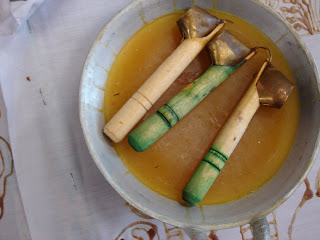Batik is a traditional Indonesian textile which is developed from Java, Indonesia.
It is thought to be named from the word ‘ambatik’ which refers to making dots; and the suffix ‘tik’ simply means dot. Thus it can be inferred that batik makes use of little dots to form various fanciful patterns.
Ibu Fanny, the teacher-in-charge of the batik group, shared with me the 4 stages to the process of batik.
1. Outline the pattern of batik on a cloth using a pencil.
2. Apply liquefied wax to the outline (waxing). This is normally carried out using a canting. Canting is a wooden handled tool with a tiny-spouted copper container. It allows the control of wax flowing through. The right temperature has to be reached for the perfect flow of the wax. If the wax is too hot, the flow of wax would be too fast for optimum control. On the other hand, if the wax is too cool, it would not be able to flow through the canting smoothly. This stage of the batik process has been commented the most tedious part, and as Ibu Fanny mentioned, the perfection of control in waxing comes with experience.



3. Apply colours on the designed cloth. Batik dyes are traditionally made from natural ingredients. The oldest colour used in traditional batik making was blue, made from the leaves of the Indigo plant.
Colourful, isn't it? :D
4. Removal of wax by ironing. The cloth is ironed between newspapers for the absorption of wax.
After which, a piece of batik art work is finally completed.
It was the third and last Batik session when I conducted the interview. The small groups of 4 each had progressed to applying colours to their designed cloths.
The students expressed fun and enjoyment in batik making. During the process, mistakes were made which were actually experiences to learn from. There was a work in which the wax applied was not thick enough to block off the colours, hence resulting in smudging. As the group members were pretty concerned over the work, Ibu Fanny reassured them, saying “It’s a learning process, and not so much about the outcome.” This is the essence of learning, isn't it? :)

Beautiful work done! :D

No comments:
Post a Comment